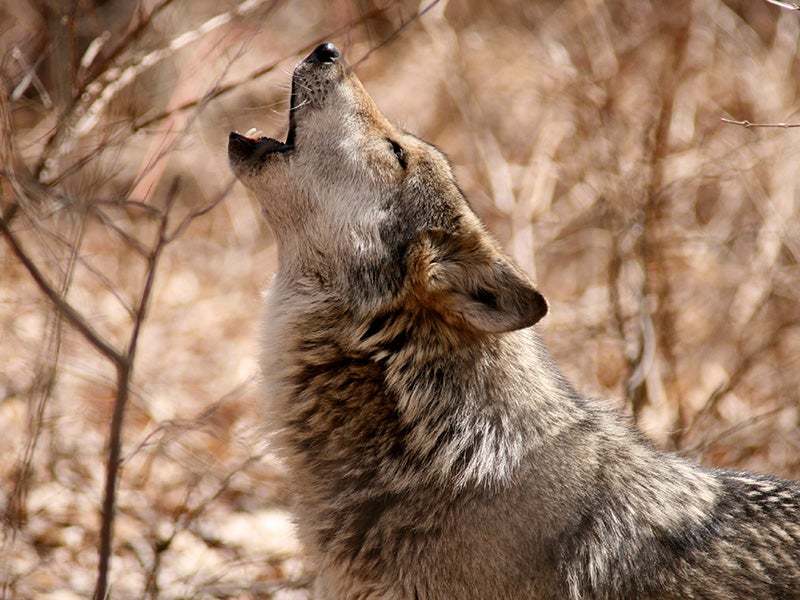How the Biodiversity Crisis Impacts All of Us
Increased threats could unravel the web of life that sustains so many species on this planet—including us.
Biodiversity means a wolf pack that inhabits the remotest corner of Yellowstone National Park—and it also means the cardinal at your backyard feeder and the butterfly in your local park. Each species is important, as each is a part of larger natural systems that we all rely on.
And today our remaining biodiversity is increasingly imperiled.
Recent scientific evidence indicates that around 1 million species already face a threat of extinction, and that nearly 40 percent of all species on Earth may be threatened with or driven to extinction by the year 2100. Even many species that are not yet on the brink of extinction have suffered huge population declines. For example, wild bird populations in the United States and Canada have declined by nearly 30 percent over the past half-century—a loss amounting to a staggering 2.9 billion breeding adult birds. In concrete terms, this means that for every two red-winged blackbirds whose song marks the onset of spring today, there were three in 1970.
The main causes for many of these losses have been well known for decades but have accelerated in recent years: destruction of habitat; pollution of land, air, and water; and over-exploitation of wildlife for food and other purposes. But now climate change is adding new threats and compounding longstanding problems by altering ecosystems, drying out lakes and streams, and warming the oceans. Other recent developments also add new perils: marine plastic pollution has increased tenfold since 1980, invasive species increasingly threaten natural environments, and urban areas have doubled in size since 1992.
These forces threaten to unravel the web of life that sustains so many species on this planet—including us. The same natural systems that make life possible for other creatures also make life possible for humans. Natural systems filter pollutants to provide clean air and water, protect soil quality, and provide pollination and pest control for agriculture. The diversity of species produced by these systems provide us with food and medicine. Natural processes help to mitigate climate change, as more than half of all human-caused carbon dioxide emissions are absorbed by natural systems that include, among others, old-growth and mature forests. And a diverse and flourishing natural world enriches our lives: scientific studies have correlated time spent in nature with reduced blood pressure and stress levels, better immune function, and improved sleep.
For all of these reasons, we are not mere observers of the declining biodiversity around us. Our own future is inextricably bound to the health of the planet we inhabit and that of the other creatures with whom we share it.
At Earthjustice, we are working harder than ever to safeguard that future. We have fought to protect biodiversity since our founding more than 50 years ago. But today we are stepping up our efforts in recognition of the scale of the current biodiversity crisis. In July 2021, we launched a new Biodiversity Defense Program to expand this branch of our work into new geographies and issue areas. In the program’s first year, we took on important new biodiversity issues, including:
- Fighting to stem water pollution in Florida that is killing off food sources for that state’s beloved manatees, resulting in an unprecedented die-off of more than a thousand manatees in 2021 and 2022 due to starvation. At stake is the health of Florida’s Indian River Lagoon, one of the most biodiverse estuaries in North America and a home for manatees and countless other species, including half of the fish caught annually in east Florida.
- Standing up for wolf populations that promote biodiversity by keeping ecosystems in balance through healthy predator-prey interactions. We partnered with the Ojibwe Tribes of Wisconsin to oppose that state’s illegal wolf-hunting plans, overturned the Trump administration’s effort to remove federal protections for gray wolves throughout most of the lower 48 states, and initiated new efforts to reform the government’s faltering Mexican gray wolf recovery program in Arizona and New Mexico.
- Opposing new harvest authorizations for horseshoe crabs that would further deplete the biodiversity of the Delaware Bay, where the crabs’ eggs fuel a globally significant stopover for migratory birds. Loss of this critical food source would threaten migratory bird species that travel each spring from the southern tip of South America to their nesting grounds in the Arctic, and would also further deplete fish and other wildlife that depend on eggs of the Delaware Bay horseshoe crab population for essential nutrition.
As these examples illustrate, sustaining a world brimming with diverse and beautiful life means protecting and restoring clean water, preserving natural systems, and making room for all species to find sufficient food and a place to live. Wild creatures need these things, but we do too. In the end, by preserving biodiversity, we also preserve ourselves.
The Biodiversity Defense Program fights to reshape our relationship to lands, water, and wildlife everywhere by confronting the major drivers of the decline in nature, including habitat destruction and over-exploitation of wildlife.
